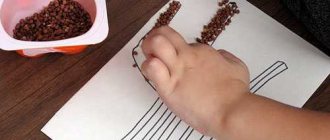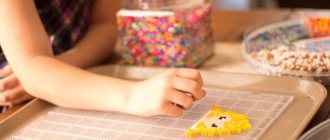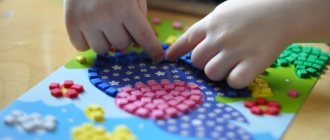Development of fine motor skills in young children (1-3 years)
At this age, children can control their movements. They not only hold toys in their hands, but also perform various actions with them. The child’s activities are constantly developing and becoming even more diverse.
At this age, it is useful to continue classes with various cereals and beads , but gradually complicate them. You can place several objects at the bottom of the bowl and cover them with cereal so that the child finds “treasures”. Gradually, the amount of cereal increases, and the items you are looking for become smaller.
It is useful to practice with various insert frames, lacing, logic sorters, serpentines, large mosaics, and game centers. You can purchase ready-made educational toys or make them yourself. You can make a fabric book or rug yourself, where your child can fasten buttons, master lacing, and make knots.
It is necessary to continue drawing lessons . First, you can use finger paints, then switch to wax pencils, markers for kids, and crayons. Vertical surfaces are useful for drawing. You can use boards, easels, and special wallpaper for drawing. At 2-3 years old, a child can easily engage with coloring books; images with large details should be chosen.
From the age of 2 you can master sand drawing . The child cannot yet draw a picture, but he can depict the simplest elements.
to work with screw caps and caps to develop fine motor skills . You can select several plastic jars of different sizes with screw caps and place toys in them. At first, the child will strive to get various objects, then he will begin to close them in jars. The task can then be complicated - use a bottle with a narrow neck and a bead or pea. The child must open the bottle himself, put the object in and close the lid again.
At this age, you need to accustom your child to books . To develop motor skills, you should turn the pages.
One of the interesting activities is finger theater . You can buy or make a doll for the whole hand or for individual fingers. First, the child will watch the performance staged by the parents, and then he will begin to take an active part in it.
Complexes of games for developing fine motor skills in young children are presented in these videos:
The influence of hand development on speech
Even in ancient times, people realized the connection between fine motor skills and speech development in children. Now this influence has evidence, since it has been found that the centers of speech and fine motor skills in the brain are formed very close to each other. Therefore, by developing motor skills, we thereby develop speech capabilities.
By performing fine motor skills exercises with hands and fingers, the child helps activate the speech center, in which the following processes occur:
- Differentiation of speech and other sounds;
- Activation of reproduction of heard words;
- Memorizing logical relationships in words, phrases and sentences.
Starting from early infancy, the child’s motor skills and speech should be purposefully developed.
Developing fine motor skills with housework
Nowadays there are a lot of toys in stores to develop children's motor skills, but mastered games often get boring. How can you ensure that your baby continually develops?
There is a little trick - let him help you around the house. After all, children love to imitate adults and will be happy to help them in adult matters, and naughty fingers will get the necessary training. Ask him:
- Remove the skin from potatoes boiled in their jackets. Peel the eggs and peel the citrus fruits;
- remove the kernel from the split walnut shell, peel off the film from the roasted peanuts;
- remove crumbs from the table with your fingers, help collect small objects from the floor: peas, buttons, beads;
- tighten the screw with a screwdriver;
- sort out different cereals;
- make manti, dumplings, cookies;
- sort out the berries;
- wash vegetables and dishes, but try to wash them only when the child is not looking, so that the child’s work does not depreciate in his eyes,
- untie packages from the store;
- weed the garden;
- transplant seedlings that you don’t mind;
- pick berries with you;
- collect supplies for crafts: cones, acorns, leaves;
- open doors and mail with a key;
- dress and undress independently, unlace and lace shoes;
- braid your hair for yourself, your mother, your sister;
- hang laundry using clothespins;
- crumple and tear off shoe paper that you put away for the winter;
- unscrew the plugs;
- sharpen pencils with a sharpener;
- find the edge of the tape and peel it off;
- get objects from under the closet and other narrow spaces where your hand cannot fit;
- carefully leaf through books;
- clean your hairbrush,
- remove pellets from clothes with your fingers;
- string beads;
- sort buttons;
- wind yarn;
- help fill homemade toys with filler (sintepon).










